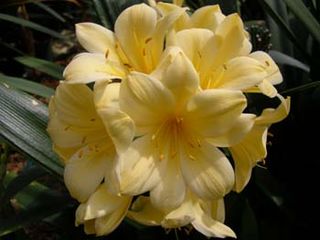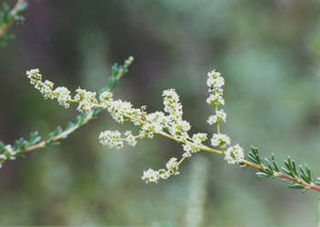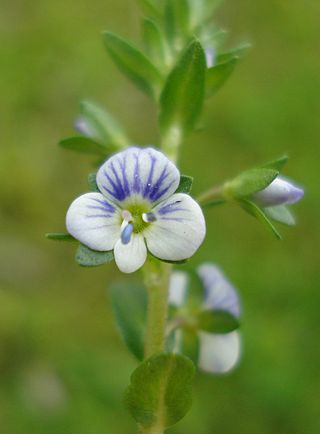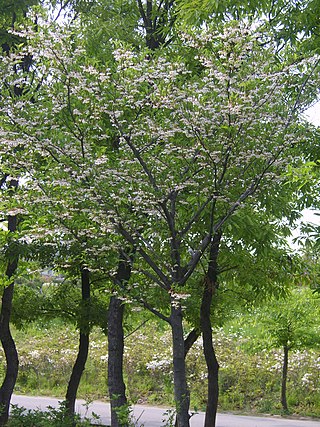
Medicago is a genus of flowering plants, commonly known as medick or burclover, in the legume family (Fabaceae). It contains at least 87 species and is distributed mainly around the Mediterranean basin. The best-known member of the genus is alfalfa, an important forage crop, and the genus name is based on the Latin name for that plant, medica, from Greek: μηδική (πόα) Median (grass). Most members of the genus are low, creeping herbs, resembling clover, but with burs. However, alfalfa grows to a height of 1 meter, and tree medick is a shrub. Members of the genus are known to produce bioactive compounds such as medicarpin and medicagenic acid. Chromosome numbers in Medicago range from 2n = 14 to 48.

Alfalfa, also called lucerne, is a perennial flowering plant in the legume family Fabaceae. It is cultivated as an important forage crop in many countries around the world. It is used for grazing, hay, and silage, as well as a green manure and cover crop. The name alfalfa is used in North America. The name lucerne is more commonly used in the United Kingdom, South Africa, Australia, and New Zealand. The plant superficially resembles clover, especially while young, when trifoliate leaves comprising round leaflets predominate. Later in maturity, leaflets are elongated. It has clusters of small purple flowers followed by fruits spiralled in 2 to 3 turns containing 10–20 seeds. Alfalfa is native to warmer temperate climates. It has been cultivated as livestock fodder since at least the era of the ancient Greeks and Romans.

Petals are modified leaves that surround the reproductive parts of flowers. They are often brightly colored or unusually shaped to attract pollinators. All of the petals of a flower are collectively known as the corolla. Petals are usually accompanied by another set of modified leaves called sepals, that collectively form the calyx and lie just beneath the corolla. The calyx and the corolla together make up the perianth, the non-reproductive portion of a flower. When the petals and sepals of a flower are difficult to distinguish, they are collectively called tepals. Examples of plants in which the term tepal is appropriate include genera such as Aloe and Tulipa. Conversely, genera such as Rosa and Phaseolus have well-distinguished sepals and petals. When the undifferentiated tepals resemble petals, they are referred to as "petaloid", as in petaloid monocots, orders of monocots with brightly colored tepals. Since they include Liliales, an alternative name is lilioid monocots.

A sepal is a part of the flower of angiosperms. Usually green, sepals typically function as protection for the flower in bud, and often as support for the petals when in bloom.

Feijoa sellowiana also known as Acca sellowiana (O.Berg) Burret, is a species of flowering plant in the myrtle family, Myrtaceae. It is native to the highlands of southern Brazil, eastern Paraguay, Uruguay, northern Argentina, and Colombia. Feijoa are also common in gardens of New Zealand. It is widely cultivated as an ornamental tree and for its fruit. Common names include feijoa, pineapple guava and guavasteen, although it is not a true guava. It is an evergreen shrub or small tree, 1–7 metres (3.3–23.0 ft) in height.

Clivia is a genus of monocot flowering plants native to southern Africa. They are from the family Amaryllidaceae, subfamily Amaryllidoideae. Common names are Natal lily or bush lily.

Medicago truncatula, the barrelclover, strong-spined medick, barrel medic, or barrel medick, is a small annual legume native to the Mediterranean region that is used in genomic research. It is a low-growing, clover-like plant 10–60 centimetres (3.9–23.6 in) tall with trifoliate leaves. Each leaflet is rounded, 1–2 centimetres (0.39–0.79 in) long, often with a dark spot in the center. The flowers are yellow, produced singly or in a small inflorescence of two to five together; the fruit is a small, spiny pod.

Mercurialis perennis, commonly known as dog's mercury, is a poisonous woodland plant found in much of Europe as well as in Algeria, Iran, Turkey, and the Caucasus, but almost absent from Ireland, Orkney and Shetland. A member of the spurge family (Euphorbiaceae), it is a herbaceous, downy perennial with erect stems bearing simple, serrate leaves. The dioecious inflorescences are green, bearing inconspicuous flowers from February to April. It characteristically forms dense, extensive carpets on the floor of woodlands and beneath hedgerows.

Adenostoma fasciculatum, commonly known as chamise or greasewood, is a flowering plant native to California and Baja California. This shrub is one of the most widespread plants of the California chaparral ecoregion. Chamise produces a specialized lignotuber underground and at the base of the stem, known as a burl, that allow it to resprout after fire has off burned its stems. It is noted for its greasy, resinous foliage, and its status as one of California's most iconic chaparral shrubs.

Clianthus puniceus, common name kaka beak, is a species of flowering plant in the genus Clianthus of the legume family Fabaceae, native to New Zealand's North Island.

Adenium obesum is a poisonous species of flowering plant belonging to the tribe Nerieae of the subfamily Apocynoideae of the dogbane family, Apocynaceae. It is native to the Sahel regions south of the Sahara, tropical and subtropical eastern and southern Africa and also the Arabian Peninsula. Common names include Sabi star, kudu, mock azalea, impala lily and desert rose. Adenium obesum is a popular houseplant and bonsai in temperate regions.

Epiphyllum oxypetalum, the Dutchman's pipe cactus, princess of the night or queen of the night, is a species of cactus. It blooms nocturnally, and its flowers wilt before dawn. Though it is sometimes referred to as a night-blooming cereus, it is not closely related to any of the species in the tribe Cereeae, such as Selenicereus, that are more commonly known as night-blooming cereus. All Cereus species bloom at night and are terrestrial plants; Epiphyllum species are usually epiphytic.

Chimonanthus praecox, also known as wintersweet and Japanese allspice, is a species of flowering plant in the genus Chimonanthus of the family Calycanthaceae, native to China. The plant is known as làméi in Chinese. The plant is also grown in Iran, where it is called gol-e yakh or "ice flower" in Persian.

Veronica serpyllifolia, the thyme-leaved speedwell or thymeleaf speedwell, is a perennial flowering plant in the plantain family. It is native to Europe, but can be found elsewhere on most continents as an introduced species.

Guazuma ulmifolia, commonly known as West Indian elm or bay cedar, is a medium-sized tree normally found in pastures and disturbed forests. This flowering plant from the family Malvaceae grows up to 30m in height and 30–40cm in diameter. It is widely found in areas such as the Caribbean, South America, Central America and Mexico serving several uses that vary from its value in carpentry to its utility in medicine.

Camassia cusickii, common name Cusick's camas or Cusick's quamash, is a species of plant in the family Asparagaceae. It is native to parts of North America. C. cusickii originally appeared in horticultural journals in the late 1800s, but they been sold and cultivated for about thirty years. This plant family is not studied intensely. Seven or eight species exist in the wild, however, only three are talked about and cultivated.

Pyrus bourgaeana, the Iberian pear, is a close relative of Pyrus communis L. The latter was domesticated about 2500 years ago. This monoecious small tree is widely distributed across the southern Iberian Peninsula and northern Morocco, where it coexists with four Pyrus species: P. communis L., P. cordata Dew., P. spinosa Forssk, and P. nivalis Jacq. Characteristics to discriminate these species are the width of fruit peduncle, petal size, leaf width and petiole length served to the taxa.
Ensifer medicae is a species of gram-negative, nitrogen-fixing, rod-shaped bacteria. They can be free-living or symbionts of leguminous plants in root nodules. E.medicae was first isolated from root nodules on plants in the genus Medicago. Some strains of E.medicae, like WSM419, are aerobic. They are chemoorganotrophic mesophiles that prefer temperatures around 28 °C. In addition to their primary genome, these organisms also have three known plasmids, sized 1,570,951 bp, 1,245,408 bp and 219,313 bp.

Iris hermona, the Golan iris, is a plant species in the genus Iris, it is also in the subgenus of Iris, and in the section Oncocyclus. It is a rhizomatous perennial, from the pastures and meadows of the Golan Heights in Israel and Syria. It has linear, upright leaves, tall slender stem holding a bi-coloured flower, having a pale lilac, cream-yellow, light tan, or white background, which is then covered in purple brown, or purple, or purple-pink veining, spots or speckling. It has a round purple-brown or almost black signal patch, and a sparse purple brown or almost black beard. It is rarely cultivated as an ornamental plant in temperate regions, as it needs very dry conditions during the summer.

Styrax japonicus, also known as the Japanese snowbell, is a species of flowering plant in the family Styracaceae, native to Korea, Japan, and Southern China. Growing to 12 m (39 ft) tall by 8 m (26 ft) broad, it is a graceful, spreading deciduous tree with oval, upward-facing leaves which occasionally turn yellow or orange before falling in autumn. Masses of slightly fragrant, bell-shaped white flowers hang from the branches in summer, followed by fruits (drupes) which resemble olives in both shape and colour.





















